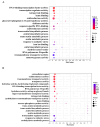Effects of Different Modified Biochars on Growth of Kosteletzkya virginica and Corresponding Transcriptome Analysis
- PMID: 40573837
- PMCID: PMC12196827
- DOI: 10.3390/plants14121849
Effects of Different Modified Biochars on Growth of Kosteletzkya virginica and Corresponding Transcriptome Analysis
Abstract
Modified biochar can effectively improve the quality and environment of coastal saline-alkali soil, but its effects on the growth and development of halophytes and its mechanism are still unclear. This study systematically evaluated the growth-promoting effects and preliminary mechanisms of H3PO4-modified biochar (HBC) and H3PO4-kaolinite-biochar composite (HBCK) on the economically important halophyte Kosteletzkya virginica. The results demonstrated that the application of HBC/HBCK significantly enhanced plant growth, resulting in increases of over 55% in plant height and greater than 100% in biomass relative to the control. Multidimensional mechanistic analysis revealed the following: (1) accumulation of nitrogen (N), phosphorus (P), and potassium (K) increased by at least 40%, significantly enhancing nutrient uptake; (2) increases in the activities of superoxide dismutase (SOD) and peroxidase (POD) by over 100% and 70%, respectively, markedly boosting antioxidant capacity and effectively alleviating oxidative stress; (3) molecular regulation via the activation of transcription factor networks (HSP, MYB, TCP, AP2/ERF, bZIP, and NLP) and modulation of key genes in ABA, BR, and JA signaling pathways (CYP707A, CYP90, and OPR2), establishing a multi-layered stress adaptation and growth promotion system. Beyond assessing the growth-promoting effects of modified biochars, this study provides novel insights into the regulatory transcription factor networks and phytohormone signaling pathways, offering theoretical foundations for the molecular design of biochars for saline-alkali soil remediation.
Keywords: Kosteletzkya virginica; modified biochar; phytohormone signaling; salt–alkali tolerance; transcription factor network.
Conflict of interest statement
The authors declare no conflicts of interest.
Figures








Similar articles
-
Preparation of Biochars from Different Sources and Study on Their Phosphorus Adsorption Properties.Molecules. 2025 Jun 18;30(12):2633. doi: 10.3390/molecules30122633. Molecules. 2025. PMID: 40572596 Free PMC article.
-
The phosphoric acid extract of fresh biochar and its compound aqueous solutions promoted tobacco plant growth by regulating nutrient-related microorganisms in rhizosphere soil.Front Microbiol. 2025 May 22;16:1601567. doi: 10.3389/fmicb.2025.1601567. eCollection 2025. Front Microbiol. 2025. PMID: 40485832 Free PMC article.
-
Physiological Mechanisms and Core Genes in Response to Saline-Alkali Stress in Foxtail Millet (Setaria italica L.).Biomolecules. 2025 Jun 12;15(6):859. doi: 10.3390/biom15060859. Biomolecules. 2025. PMID: 40563499 Free PMC article.
-
Promotion of Ca2+ Accumulation in Roots by Exogenous Brassinosteroids as a Key Mechanism for Their Enhancement of Plant Salt Tolerance: A Meta-Analysis and Systematic Review.Int J Mol Sci. 2023 Nov 9;24(22):16123. doi: 10.3390/ijms242216123. Int J Mol Sci. 2023. PMID: 38003311 Free PMC article.
-
Levetiracetam add-on for drug-resistant focal epilepsy: an updated Cochrane Review.Cochrane Database Syst Rev. 2012 Sep 12;2012(9):CD001901. doi: 10.1002/14651858.CD001901.pub2. Cochrane Database Syst Rev. 2012. PMID: 22972056 Free PMC article.
References
-
- Zhang P., Bing X., Jiao L., Xiao H., Li B., Sun H. Amelioration effects of coastal saline-alkali soil by ball-milled red phosphorus-loaded biochar. Chem. Eng. J. 2022;431:133904. doi: 10.1016/j.cej.2021.133904. - DOI
-
- Li Q., Xi M., Wang Q., Kong F., Li Y. Characterization of soil salinization in typical estuarine area of the Jiaozhou Bay, China. Phys. Chem. Earth Parts A/B/C. 2018;103:51–61. doi: 10.1016/j.pce.2017.06.010. - DOI
-
- Zhang S., Hong Q., Guo H. Research on the Impact of Coastal Land Reclamation on Geomorphic Complexity and Tidal Energy Dissipation—A Case Study of Zhoushan Islands, Hangzhou Bay. Eng. Rep. 2025;7:e13075. doi: 10.1002/eng2.13075. - DOI
-
- Li T., Wang S., Liu S., Zhang X., Dong H., Dai S., Chai L., Li H., Lv Y., Li T., et al. Trade-offs of organic amendment input on soil quality and crop productivity in saline-alkali land globally: A meta-analysis. Eur. J. Agron. 2025;164:127471. doi: 10.1016/j.eja.2024.127471. - DOI
Grants and funding
LinkOut - more resources
Full Text Sources
Research Materials

